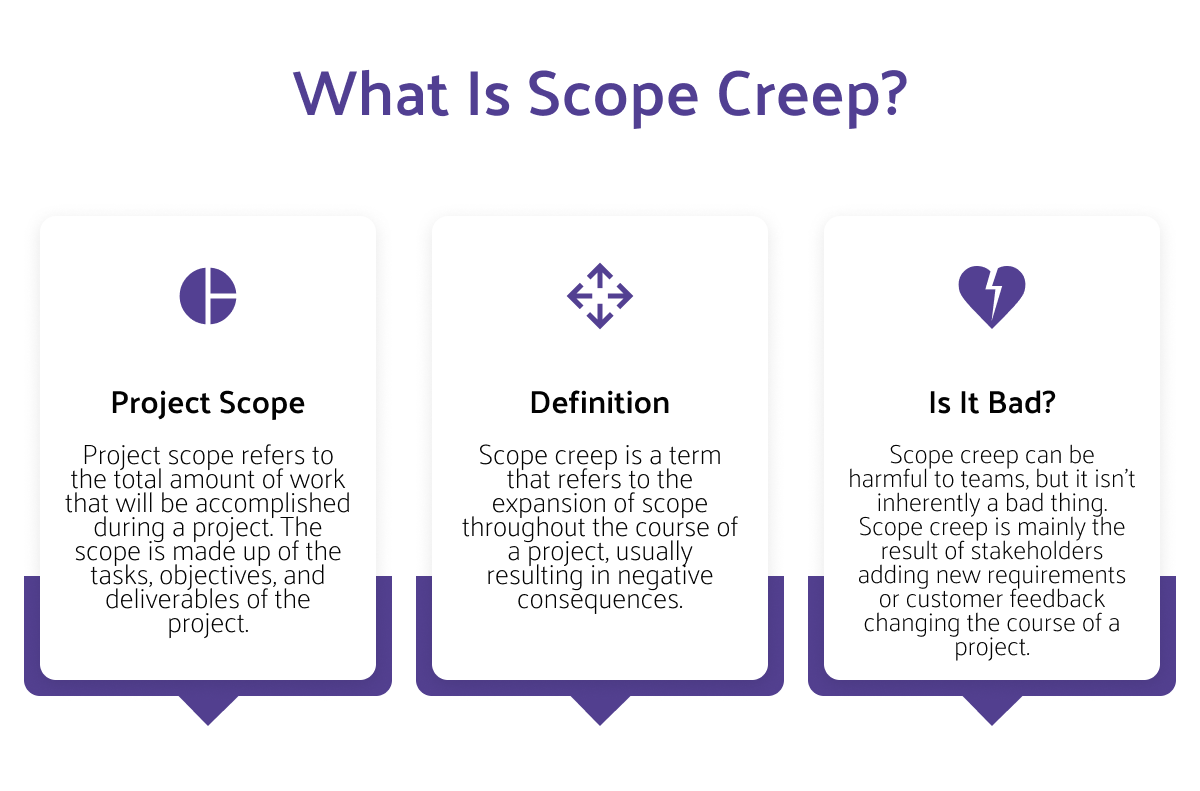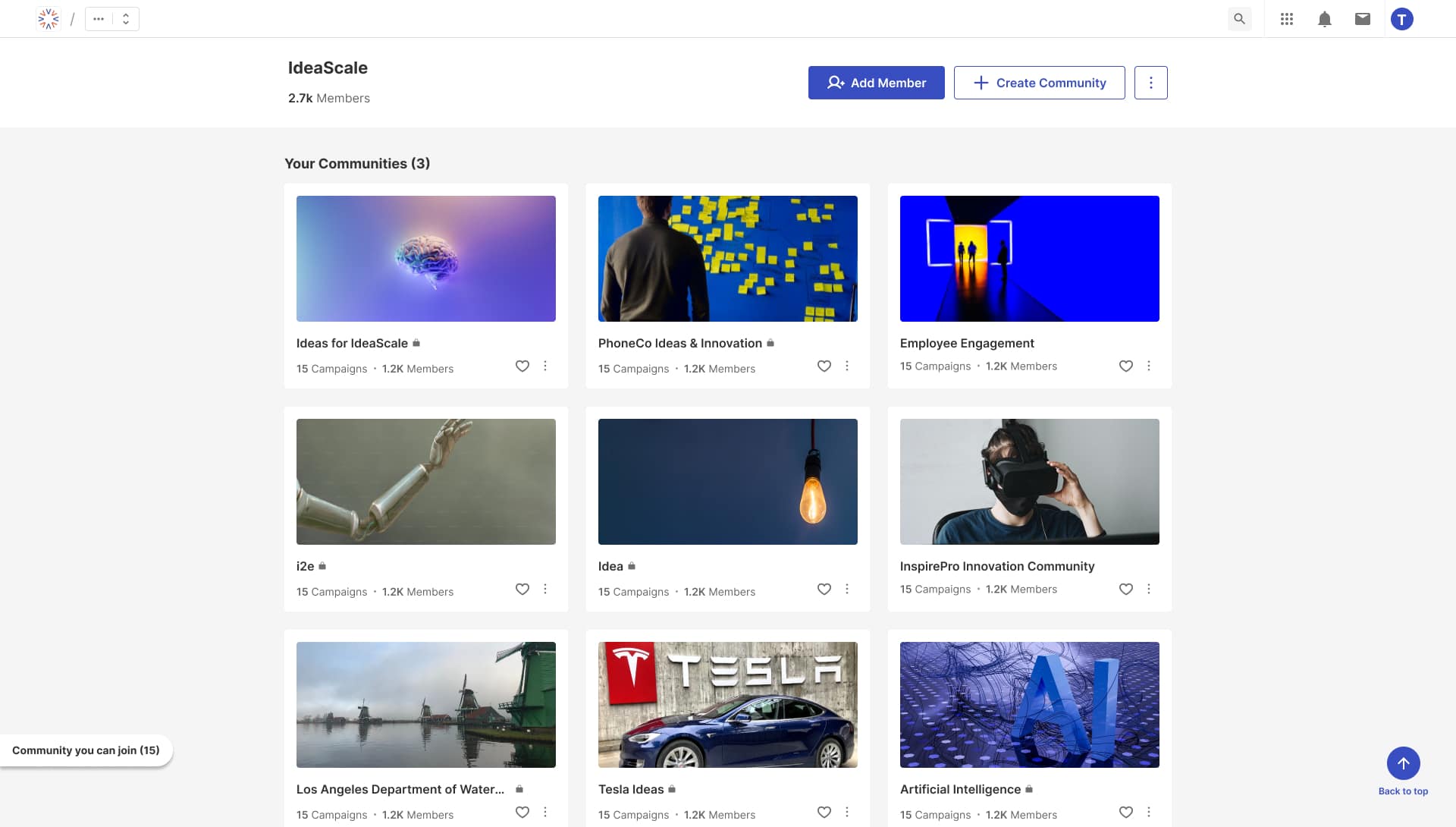In order to complete a project successfully, a lot of things need to go right. Some of these things will be within your control, like communication and organization, but some won’t, like stakeholder requirements and customer feedback. When optimizing the tasks you can control, the last thing you want to happen is for the project to balloon into something it wasn’t meant to be. When your project scope is bloated, meeting deadlines seems increasingly unrealistic. The common term for these increasing requirements is scope creep, and in this article, we will define scope creep and discuss how it affects project success.
What is Scope Creep?
Scope creep, a common challenge in project management, is defined as the gradual and unauthorized expansion or modification of a project’s original objectives, goals, or deliverables. This phenomenon occurs when additional features, requirements, or tasks are introduced without proper evaluation or approval, leading to a deviation from the initial project scope. It is crucial to establish clear project requirements, timelines, budgets, and boundaries at the project’s outset to prevent scope creep. Recognizing and managing changes promptly is essential to ensure projects stay on track and deliver the intended outcomes.
Scope Creep in Project Management
Scope creep can be a challenging issue in project management because it can result in:
- Increased Costs: Additional features or changes to the project often require more resources, which can lead to higher costs than originally budgeted.
- Extended Timelines: As the scope of the project expands, the time required to complete it may also increase, leading to delays in project delivery.
- Resource Overallocation: Teams may find themselves stretched thin as they try to accommodate new requirements without additional resources.
- Quality Issues: Rushed or unplanned changes can compromise the quality of the project deliverables.
- Stakeholder Dissatisfaction: Changes to the project’s scope may not align with the expectations of stakeholders, leading to dissatisfaction and potential conflicts.
To mitigate scope creep, project managers need to establish clear and well-defined project scopes, communicate effectively with stakeholders, and implement a robust change control process. This process involves evaluating proposed changes, determining their impact on the project’s scope, schedule, and budget, and obtaining approval before implementing them. Additionally, having a well-documented project scope statement and keeping stakeholders informed throughout the project can help prevent scope creep by managing expectations and ensuring that everyone is aligned with the project’s objectives.
To manage scope creep effectively, project managers should:
- Clearly Define the Scope: Clearly outline the project scope at the beginning, detailing what is included and what is not. This provides a baseline for managing changes.
- Establish a Change Control Process: Implement a formalized process for reviewing and approving changes to the project scope. This helps ensure that all changes are assessed for their impact on time, cost, and resources.
- Communicate Effectively: Sustain transparent and open lines of communication with all relevant stakeholders. Keeping everyone informed about the project’s progress and any proposed changes helps manage expectations.
- Regularly Review and Update the Scope: Periodically review the project scope to ensure it aligns with the project’s objectives. If changes are necessary, they should be formally documented and approved.
By proactively managing scope and changes, project managers can minimize the impact of scope creep and increase the likelihood of delivering a successful project on time and within budget.
6 Top Causes of Scope Creep
Understanding how to avoid scope creep within a project is helpful, but you should also know some of the key triggers so you can successfully address the root cause of the problem rather than the symptom. Here are some of the biggest causes of scope creep during the project cycle.
1. Lack of Scope Definition: From the outset, it’s important to have a clear project scope. Knowing exactly what will be included and what will be omitted is critical to achieving project success. When you have a clear scope, everyone will work towards the same end goal and can depend on this shared objective throughout their workflow. If you sense a lack of clarity from the initial stages of the project, you might need to take a step back and formalize the project scope.
If you need help understanding how to put together a project’s requirements, try using our MoSCoW Analysis to organize your priorities.
2. Miscommunication: Improper communication is a project killer and a telling sign of scope creep. Distributing project information and holding regular meetings to communicate changing needs, priorities, and progress is the best way to keep people up to date on the project’s status. Communicating often and through shared documentation is the best way to avoid scope creep, and miscommunication is a common sign that a project might not finish with the required objectives.
3. Unclear End Goal: Similar to needing a clear scope at the beginning of a project, you need to have a very clear idea of what the final product will look like. The project scope focuses on the path forward, while the end goal focuses on what the delivered final product will look like. Even if you have a clear path forward, if you don’t have a clear idea of what the end product looks like, it can be extremely easy to take on an increasing amount of work along the way and lose sight of the project’s goals. For this reason, lacking a clear end goal is a key indicator that scope creep is likely to occur.
4. Unrealistic Goals: Understanding your end goal is important, but not if that end goal is so unrealistic that it can’t feasibly be reached in the project timeframe. If this is the case, it’s very likely that your project will experience scope creep or continuously miss deadlines.
In this case, it’s important to communicate with stakeholders about the needs of the project and what timeline & environment is required to facilitate success. With improper communication between the project team and stakeholders, it’s likely that you’ll feel the pains of scope creep due to unrealistic goal setting.
5. Stakeholder Influence: Involving stakeholders in the project cycle is key, as they are the tastemakers for the features, progress, and needs of the project. They can have an extremely positive impact if they collaborate effectively with the team but can also create big problems if they don’t communicate properly.
When stakeholders try to influence the project without a clear idea of what is required, they can create a confusing and mismanaged set of priorities, resulting in a chaotic scramble to finish the project on time with the correct features. When stakeholders don’t collaborate in their involvement, it can have serious consequences on the project. If you want to build project roles, you should consider trying a RACI matrix to elaborate on the various roles in project management
6. Customer Feedback: Customer feedback should be the driving force behind any project and is a key indicator of the vision and inspiration of a project. When customer feedback is made a priority early on, it can help create an accurate timeline and priority list for the project team.
Customer feedback doesn’t always come at the right time, however, and some late pieces of feedback could alter the course of the project and require some last-minute changes. This is a surefire sign that you’ll encounter scope creep, but if it means that the project will more accurately target the customer’s needs, it’s probably worth it in the end.
Scope Creep Example
Scope creep refers to the uncontrolled expansion or modification of a project’s original objectives, goals, and requirements. It can lead to budget overruns, missed deadlines, and overall project inefficiencies. Below are several typical instances of scope creep:
- Feature Creep: Additional features or functionalities are added to a project that was not part of the initial project scope. For example, in software development, a client may request new features that were not originally included in the project specifications.
- Change in Requirements: When project stakeholders change their requirements or expectations during the project, this can result in scope creep. For instance, a client might decide they want a website to have a completely different design after development has already begun.
- Inadequate Planning: Poor initial project planning and definition can lead to scope creep. If the project scope is not clearly defined from the start, it becomes more susceptible to changes and expansions.
- Uncontrolled Stakeholder Input: Too many people offering input and making changes to the project can lead to scope creep. It’s important to have a clear process for managing stakeholder feedback and changes.
- Gold Plating: This occurs when team members or stakeholders go beyond the defined requirements to add extra features or enhancements because they believe it will make the project better. While this may seem positive, it often leads to scope creep.
- Schedule Extensions: Delays in project timelines can lead to scope creep. If a project falls behind schedule, stakeholders might insist on adding new features or tasks to “make up for lost time.”
- Lack of Documentation and Communication: Inadequate documentation or communication can result in misunderstandings and unrecorded changes to the project scope. It’s essential to maintain clear records and communicate changes effectively.
- External Factors: Changes in the external environment, such as new regulations or market conditions, can force a project to adapt, potentially expanding its scope.
- Assumption Errors: When project stakeholders make assumptions about what’s included in the project scope, it can lead to misunderstandings and scope creep. Clear documentation and communication can help prevent this.
- Vendor-Induced Scope Creep: In cases where an external vendor or contractor is involved, they might encourage scope creep to increase project costs or extend the project duration to their benefit.
- Scope Expansion Due to Success: Sometimes, a project’s initial success can lead to scope creep. For example, a successful marketing campaign might prompt stakeholders to expand its reach, even though the original scope was met.
- Evolving Technology: In technology projects, the rapid pace of innovation can lead to scope creep as stakeholders seek to incorporate the latest technologies and trends during the project.
To mitigate scope creep, it’s crucial to have a well-defined project scope, effective change control processes, and strong project management practices that prioritize communication and documentation. Clear stakeholder expectations and project boundaries should be established from the project’s outset to minimize the risk of scope creep.
Is Scope Creep Inherently Harmful?
Scope creep can be harmful to teams, but it isn’t inherently a bad thing. Scope creep is mainly the result of stakeholders adding new requirements or customer feedback changing the course of a project. In the end, delivering a product that meets the customer’s needs and adds value to their life is the main goal, so if their feedback alters the course of a project and increases the project’s value, it can have a positive impact.
Creating more value for the customer isn’t the only reason scope creep exists, however, and it can have a negative impact on your team. Adding new features and requirements within the constraints of the original product means leaving less time for other important tasks and can result in missed deadlines and a half-baked end product. Depending on the additions to your project, scope creep can either increase the value of your product or harm your team’s workflow. Either way, scope creep will always be a pertinent factor in project management and is something every good project manager must plan for.
How To Deal With Scope Creep?
Dealing with scope creep effectively is essential to ensure that a project stays on track, within budget, and on schedule.
How to Avoid Scope Creep
When scope creep occurs, it’s easy to look back and see mistakes in the process that led to your existing issue. When planning ahead, here are some strategies to ensure you’re able to avoid scope creep in the future.
1. Clear Project Definition
The most important thing you can do at the beginning of a project is to create a clear, precise definition of your project. This will include information about the final product, general goals, and specific tasks. Doing this allows your team to create a shared idea about what the project will look like and what each individual step will be to achieve the final result.
2. Create Clear Priorities
After you’ve created a document detailing project direction, you should establish clear priorities for your team. Within the project direction, there should be a clear set of priorities your team will follow en route to completion. These priorities will help clear up the emphasis of the project and can help the team understand what features are most important to the final product.
3. Create Shared Documentation
One of the biggest reasons scope creep occurs is miscommunication and lack of proper documentation. To ensure this doesn’t happen, you should create shared documentation with your team and utilize these resources throughout the project cycle. Using Ideascale Whiteboard allows you to integrate an online whiteboard and a task manager into your collaborative project cycles, meaning every team member can access and communicate their needs whenever necessary.
4. Outline Potential Traps
An experienced project manager will understand that there are certain traps that your team can fall into when navigating a project. Certain pieces of language like “It shouldn’t take long” or “While you’re at it…” can be key signs that it will, in fact, take long. It’s important to notice when people ask your team to take on more responsibility and consider how this might negatively affect the project as a whole.
5. Communicate Project Reorganization
One of the key factors in combating scope creep is communication. Communicating vision, tasks, and priorities is essential to a successful project, and this communication must also extend to any project reorganization. Reprioritizing and reorganizing your project is a crossroads where miscommunication can become extremely harmful. In these scenarios, make an active effort to over-communicate to ensure everyone is on the same page. This is a key factor in avoiding scope creep and can save your team from doubling down on outdated priorities.
6. Collaborate Regularly
The best way to avoid miscommunication is by simply collaborating frequently and working together on every part of the project. Collaboration is a crucial part of delivering a successful, well-informed project, and using tools like IdeaScale Whiteboard enables you to collaborate on any part of the project cycle.
Why is Avoiding Scope Creep Beneficial?
As previously mentioned, scope creep doesn’t always have a negative impact. There are times when it can more accurately meet a customer’s needs. Most of the time, however, scope creep can derail a project and cause teams to lose interest and connection with their work. Avoiding scope creep helps teams stick to deadlines more consistently and deliver work they’re proud of, increasing team morale and belief.
Scope creep can be disruptive to the workflow of an entire team, and if experienced often, it can hurt the engagement that people have with their projects. Consistent, clear-cut deliverables build confidence within a team and also translate into better results, which is something your customers will surely feel.
For these reasons, it’s worth taking measures to purposefully avoid scope creep, so it doesn’t have a negative effect on your projects.
Conclusion
Proper planning and communication are important for any part of a business, but they can be especially impactful for project managers. Scope creep is a consequence that every project manager needs to plan ahead for, and through this guide, you can guarantee to smash your next project out of the park.
Most Recent Posts
Explore the latest innovation insights and trends with our recent blog posts.













